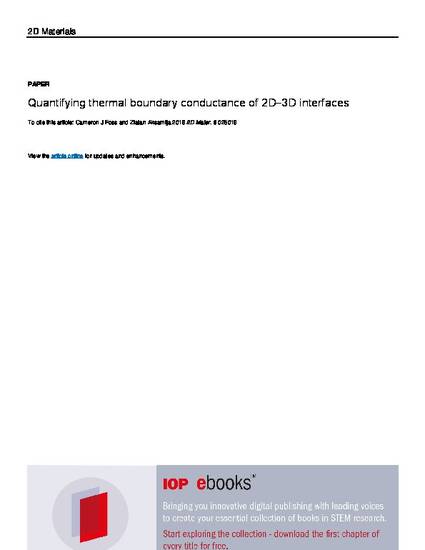
Article
Quantifying thermal boundary conductance of 2D–3D interfaces
2D Materials
(2019)
Abstract
Heat dissipation in next-generation electronics based on two-dimensional (2D) materials is a
critical issue in their development and implementation. A potential bottleneck for heat removal in
2D-based devices is the thermal pathway from the 2D layer into its supporting substrate. The choice
of substrate, its composition and structure, can strongly impact the thermal boundary conductance
(TBC). Here we investigate the temperature-dependent TBC of 42 interfaces formed between a
group of six 2D materials and seven crystalline and amorphous substrates. We use first-principles
density functional perturbation theory to calculate the full phonon dispersion of the 2D layers and
substrates and then input them into our model for phonon transport across the 2D–3D interface.
Our results show that the TBC depends on the overlap between the vibrational frequencies and
can be varied by nearly two orders of magnitude, from as low as ∼0.6 MW · m−2 · K−1 (h-BN on
diamond) to ∼40 MW · m−2 · K−1 (h-BN on SiO2), for the same 2D layer by changing the substrate
material. We find that amorphous materials significantly boost the TBC relative to their crystalline
counterparts, assuming the two interfaces have the same adhesion, owing to the low-frequency
Boson peak feature in their vibrational density of states (vDOS). For crystalline substrates, we
further correlate constituent material properties with the calculated TBCs and find that the TBC
strongly depends on a combination of the speed of sound, Debye temperature, and density of the
substrate as well as the bandwidth of the flexural branch in the 2D material. We conclude that softer
substrates with sharp low-frequency features in their vDOS, such as amorphous materials, polymers,
and nanoparticles, could have higher TBC, leading to a trade-off between TBC and the thermal
conductivity of the substrate.
Keywords
- thermal boundary conductance,
- 2D materials,
- graphene,
- transition metal dichalcogenides,
- phonons
Disciplines
Publication Date
Winter February 27, 2019
DOI
10.1088/2053-1583/ab04bf
Citation Information
Zlatan Aksamija and Cameron J Foss. "Quantifying thermal boundary conductance of 2D–3D interfaces" 2D Materials (2019) Available at: http://works.bepress.com/zlatan_aksamija/8/
